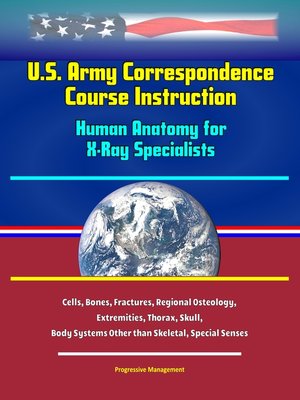U.S. Army Correspondence Course Instruction
ebook ∣ Human Anatomy for X-Ray Specialists--Cells, Bones, Fractures, Regional Osteology, Extremities, Thorax, Skull, Body Systems Other than Skeletal, Special Senses
By Progressive Management

Sign up to save your library
With an OverDrive account, you can save your favorite libraries for at-a-glance information about availability. Find out more about OverDrive accounts.
Find this title in Libby, the library reading app by OverDrive.



Search for a digital library with this title
Title found at these libraries:
| Library Name | Distance |
|---|---|
| Loading... |
Professionally converted for accurate flowing-text e-book format reproduction, this is a reproduction of a U.S. Army Correspondence Course Instruction: U.S. Army Correspondence Course Instruction - Human Anatomy for X-Ray Specialists.
Introduction * Lesson 1 - Introduction To Human Anatomy * Section I. Orientation * Section II. Cells * Section III. Bones * Section IV. Common Fractures * Lesson 2 - Regional Osteology * Section I. Upper Extremity * Section II. Lower Extremity * Section III. The Vertebral Column * Section IV. The Thorax * Section V. The Skull * Lesson 3 - Body Systems Other Than Skeletal * Section I. The Digestive System * Section II. The Urogenital System * Section III. The Respiratory System * Section IV. The Nervous System * Section V. The Circulatory System * Section VI. The Endocrine System * Section VII. The Special Senses
As an X-ray specialist (technologist), you need to have a good understanding of human anatomy, especially as it relates to identifying anatomical landmarks, positioning a patient correctly and comfortably, for the making of radiographic exposures. Many structures of the body are radiopaque (impenetrable by x-ray). Others can be made so. These are the structures that are of primary interest to you, and the area of primary emphasis in this subcourse. Thus, this subcourse is not a broad introductory course in anatomy. Rather, it makes several assumptions, that you, the reader, already have a general basic knowledge of human anatomy and physiology, and that you have a good working knowledge of medical terminology.
The human body is a complex organism made up of various interdependent systems and components. Anatomy is the study of these components and the systems that they comprise. Put another way, anatomy is the study of the structure of the body, and the spatial relationship of its parts. Radiographic anatomy is the study of body structures that can be satisfactorily recorded as images of varying densities on x-ray film. Although the primary emphasis in radiographic anatomy will be on the skeletal system, as an X-ray technologist, you should be familiar with the structure of the whole body, and the interdependent systems of which it is comprised. A detailed study of human anatomy and physiology is beyond the scope of this subcourse. Fortunately, you do not require such detailed knowledge. However, a basic knowledge of bones and their joints, their locations, and their surface landmarks, is essential for proper positioning of the patient. You should also know sufficient detail of the internal organ systems, including their components, locations, and functions, to perform the various radiographic procedures.







